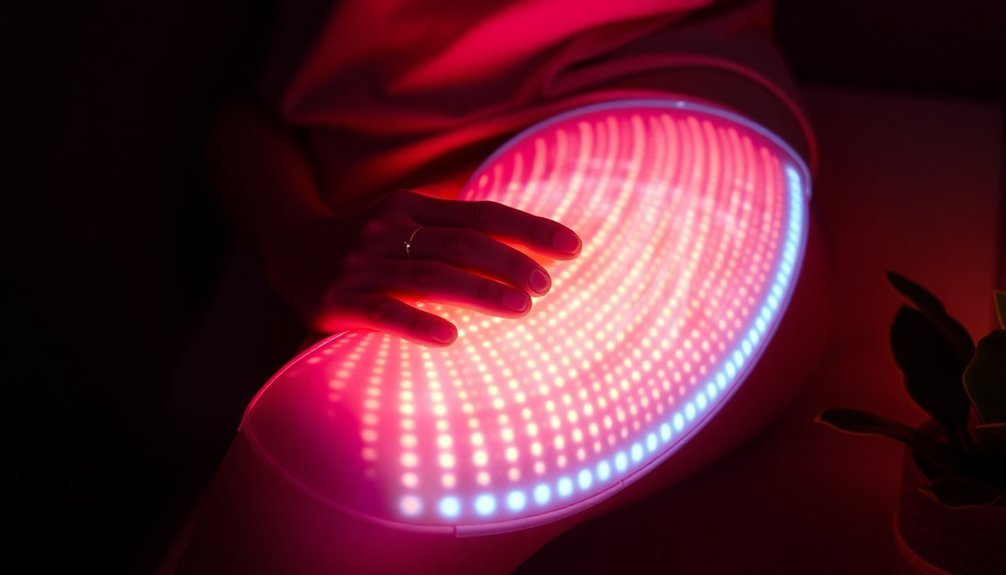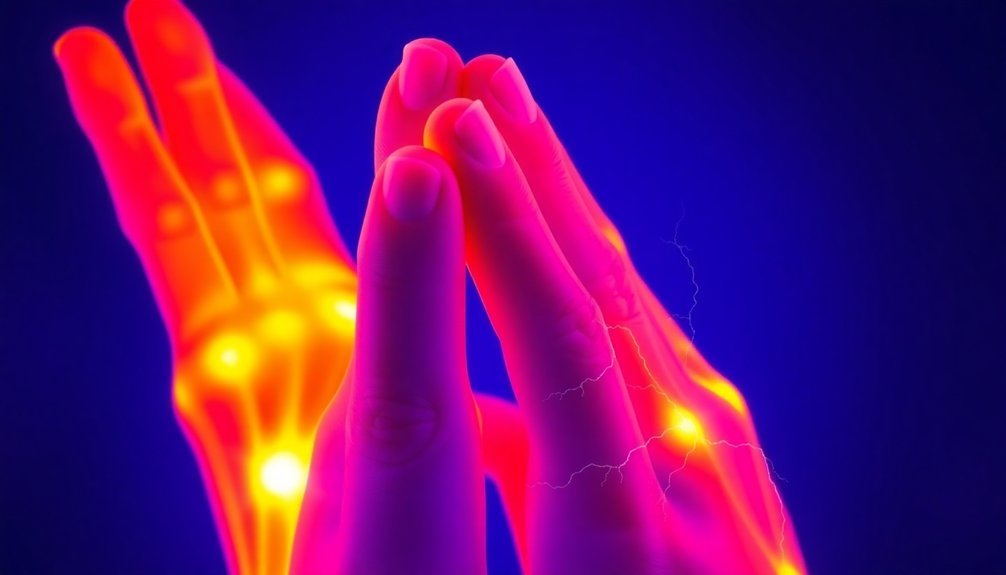Infrared therapy can substantially improve your joint pain through three powerful mechanisms. First, it penetrates deep into your tissues, enhancing blood circulation to deliver essential nutrients and oxygen directly to damaged areas. Second, it activates your cells' mitochondria to boost energy production and accelerate natural healing processes, helping repair damaged joints and reduce inflammation. Third, it stimulates collagen production to strengthen your ligaments, tendons, and cartilage while improving flexibility and range of motion. These natural healing benefits come without the side effects of traditional pain medications, making it an effective long-term solution for joint health.
Natural Healing Without Side Effects

The promise of natural healing draws many people to infrared therapy as a solution for joint pain. When you use infrared therapy, you're tapping into your body's innate healing mechanisms without relying on medications or invasive procedures.
The therapy works by stimulating cellular regeneration and boosting collagen production, which directly supports your joint health and flexibility. Studies have shown that red and infrared light can provide pain relief up to 50% in patients with degenerative osteoarthritis.
You'll benefit from improved blood circulation as the infrared light penetrates deep into your tissues, delivering essential oxygen and nutrients to damaged areas. The therapy also activates your mitochondria – your cells' power plants – enhancing energy production and accelerating tissue repair.
What's particularly appealing is that you won't have to worry about significant side effects or developing a dependency, unlike with many pain medications.
If you're concerned about safety, you'll be relieved to know that infrared therapy is non-invasive and carries minimal risk. While you might experience mild redness or skin irritation, there's no long-term damage to worry about.
You can even combine this treatment with other therapies you're currently using, making it a flexible addition to your joint pain management strategy.
Deep Tissue Pain Relief
Building on these natural healing principles, infrared therapy excels at targeting stubborn deep tissue pain that other treatments often can't reach. When you receive infrared therapy, the light penetrates deep into your muscles, nerves, and bones, addressing pain directly at its source.
You'll experience enhanced blood circulation as the infrared light causes your blood vessels to expand. This improved blood flow delivers essential nutrients and oxygen to damaged tissues while removing toxins that contribute to pain and inflammation. Infrared light wavelengths of 700 to 1,000 nanometers are particularly effective for healing inflammatory conditions.
As a result, you'll notice faster healing and reduced discomfort in affected areas.
The therapy's ability to relax tense muscles is particularly beneficial if you're dealing with chronic pain conditions. You'll find your flexibility and range of motion improve as the infrared light breaks down scar tissue and releases muscle tension.
What's more, the treatment stimulates your body's production of endorphins, providing natural pain relief.
Whether you're struggling with lower back pain, arthritis, or fibromyalgia, infrared therapy offers targeted relief. Regular sessions can help maintain muscle health and prevent recurring pain, making it an effective solution for long-term pain management without invasive procedures.
Cellular Repair and Regeneration

Inside your body, infrared therapy triggers powerful cellular repair mechanisms that accelerate healing at the microscopic level. When infrared light penetrates your tissues, it stimulates your cells' mitochondria to produce more ATP, the essential energy source that powers cellular repair and regeneration.
This boost in energy production helps your body heal faster, particularly in areas affected by joint pain and inflammation. Athletes and active individuals can experience shorter recovery periods between physical activities.
You'll benefit from improved blood circulation as infrared therapy promotes new blood vessel formation and enhances blood flow. This increased circulation delivers crucial oxygen and nutrients to damaged tissues while removing harmful toxins.
The therapy also stimulates your body's natural collagen production, strengthening ligaments, tendons, and cartilage that support your joints.
What's particularly remarkable is how infrared therapy reduces inflammation through the regulation of reactive oxygen species and the production of nitric oxide. These processes help relax your arteries and minimize tissue damage.
Unlike traditional medications, infrared therapy offers a non-invasive approach to reducing inflammation and managing joint pain, while simultaneously promoting your body's natural healing mechanisms through enhanced cellular repair and regeneration.
Frequently Asked Questions
How Long Does Each Infrared Therapy Session Typically Last?
You'll typically spend 15-30 minutes in an infrared therapy session. If you're using a handheld device, plan for 5-10 minutes, while full-body panels require longer sessions for best results.
Can Infrared Therapy Be Used Alongside Other Pain Management Treatments?
Yes, you can safely combine infrared therapy with other treatments like physical therapy, exercise programs, and traditional pain management methods. It's often more effective when integrated into a thorough treatment approach for pain relief.
How Soon Can Patients Expect to Notice Improvements in Joint Pain?
You'll likely notice minor relief after your first session, but expect significant improvements within 2-4 weeks of regular treatment. For long-term healing and substantial pain reduction, continue therapy for 3-6 months.
Are There Specific Conditions Where Infrared Therapy Should Be Avoided?
You shouldn't use infrared therapy if you have recent burns, malignant cancers, or hyperthyroidism in the neck area. It's also not recommended if you've got metal implants, pacemakers, or are under alcoholic influence.
What's the Recommended Frequency of Infrared Therapy Sessions for Optimal Results?
You'll get the best results with 15-minute sessions 3-5 times weekly. Start with shorter daily treatments and gradually increase if needed. For chronic conditions, you can safely use it once or twice daily.
In Summary
You'll find infrared therapy offers a compelling natural solution for joint pain management. Whether you're seeking relief from arthritis or sports injuries, this treatment penetrates deeply without medication side effects. By stimulating cellular repair and increasing circulation, you're giving your body the tools it needs to heal naturally. Try incorporating infrared therapy into your wellness routine – your joints will thank you.





Leave a Reply